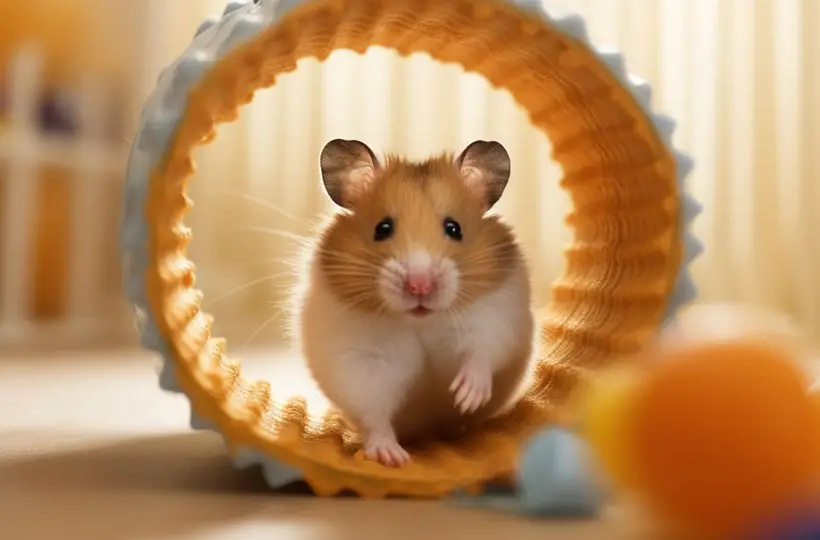Syrian Hamster Care: Food, Habitat, Health, and Facts + Expert Tips
The Syrian hamster, also called the Golden hamster, is the most popular hamster pet. This rodent is under the family Cricetidae, the second-largest of the mammals. Their popularity is because they’re easy to take care of, making them ideal for children and adults.
So, what is involved in Hamster Care? Hamster care involves providing ideal habitat and a healthy yet balanced diet. Like other pets, the hamster should get regular checks from a veterinarian specializing in hamster care.
The article covers in detail information about hamster care, including diet, habitat, and health. It also includes expert tips to help improve your time with the Syrian hamster, so read on.
Syrian Hamster Care
As mentioned above, Syrian hamsters are the most popular of the five species kept as pets. If you’re out shopping for a new pet, they should be your first option, especially if for your kid.

- These pets are easy to care for and are not demanding once everything they require is provided.
- Like other pets, they need ideal habitat, diet, and regular health check-ups to remain healthy and active.
- Their lifespan is between two and three years.
- However, Syrian hamsters cannot live in pairs as they’re solitary animals. They can be violent towards each other, which involves squabbles and fights, especially if they are females. This behavior is also in Chinese hamsters who cannot stay in pairs.
- If you aim to keep two or more hammies, you may have to go with other species, like a dwarf or Bobrovski’s.
- However, during the estrous cycle, you can provide your female hamster pet with a mate in a neutral cage.
Habitat Requirements
Golden hamsters are natives of Syria and their natural habitats are usually hot and arid. The conditions must be ideal in the home environment to keep them comfortable.

Other than temperature, there are other requirements, especially when setting up their cage. They include
1. Cage size
Hamsters are active pets, so their cage needs to be large to allow more space to free roam. So their cages should be at least 24 inches long and 12 inches wide. The height depends on whether you require several floors, but be at least 12 inches.
2. Material
The cage material can be wire mesh, aquariums, or plastic and the cage also needs lining from soft materials that absorb moisture with breakable fibers. Some cages have two materials, like a mesh top and a plastic or grass tank bottom. The bottom needs to be solid to provide enough space to add borrowable materials and prevent spillage.
3. Cage positioning
A hamster cage should be in a quiet and well-lighted spot in a room where other pets cannot reach. Avoid placing them under direct sunlight, in front of an air conditioning vent, or in damp or draughty areas.

4. Cleaning
Clean a Syrian Hamster’s cage at least after every two weeks. They prefer to pee in one position of the cage, which makes cleaning easier. However, due to their territoriality, cleaning shouldn’t be done too often as it can stress them.
5. Bedding Material
The cage also needs lining from soft materials that absorb moisture and with breakable fibers. Some of the ideal materials are cotton, hay, toilet paper, and hemp.
6. Extras
A hamster cage also requires extra materials for entertainment and exercise. The pet requires an exercise wheel to run on at night and toys to keep them entertained. The toys can include tunnels, ladders, and tubes, and some also enjoy suspended bridges to climb on. Hamsters also need a chewable item to take care of their ever-growing incisors.
Diet Requirements
Syrian hamsters are omnivores, meaning they can eat both plants and animals. In the wild, they eat seeds and grains, like oat, wheat, and barley, and insects, like crickets and their larvae.

Their diet requirements include at least 16% percent proteins and at least 5% fat. They can also feed on various seeds for vitamins and healthy vegetables. Hamsters eat a commercial mixture of pellet foods with different seeds that suit their diet. These pellets and seeds should make up over 70% of their diet.
At least 20% should be fresh foods, like greens and root vegetables. Some of the vegetables they enjoy eating include carrots, broccoli, squash romaine lettuce, cucumber, and spinach. Treats should be less than 5% of the diet and should include fruit varieties.
Some of the fruits they can enjoy include apples, bananas, berries, and grapes. However, all treats should be occasional as too much can cause diarrhea.
The pets also require a supply of clean water that they can access anytime they want. Serve the water in a bowl or through a drinking bottle, also called a drinker.

Syrian hamsters can be selective while feeding and only feed on certain foods leaving others. To avoid this scenario, feed them on nuggets that have essential nutrients.
However, avoid feeding the pet the following foods;
- Apple seeds
- Raw rhubarb or its leaves
- Garlic
- Onions
- Citrus fruit
- Almonds
- Raw potatoes
- Raw beans
- Red meat or seafood
Syrian Hamster Feeding Time and Amount

- Syrian hamsters should eat at least one tablespoon of food daily, about 12 grams. The reason the amount is necessary is that these pets are opportunistic feeders and also hoarders.
- They can stuff some of their food in their cheeks and hoard them in their burrows for future consumption. Therefore, if you continue feeding them more, these stashes go bad and invite pests.
- Syrian hamsters are active from dusk through the night, which is when you should feed them.
- In the wild, during the night, they gather food, dig burrows, and feed.
- After feeding, remove unfinished foods from the cage before serving fresh ones.
Syrian Hamster HealthCare
Like most pets, hamsters need to be regularly checked by a veterinarian to determine their health. However, keeping the pets healthy is not a complicated job and requires the owner to be keen on diet and keep them in a clean environment.
Hamsters are prone to fur and ear mites, which can cause crusting on their faces and ears, hair loss, and restlessness. You can tell a mite infestation problem in its early stages if the pet has red spots on its face, skin, and tail. They attract mites from bedding and drop medicines are used to treat them.

As mentioned earlier, hamsters are opportunistic feeders, which can affect their health negatively. Overfeeding can lead to conditions like obesity, which most pet hamsters are prone to.
Also, regular sugary treats can harm the pet’s teeth, causing cavities. However, the major dental problem is from overgrown incisors which can poke gum and tongue resulting in breeding. Chew toys help prevent this problem.
On the contrary, if your pet is not feeding, it might be a sign of health problems. Lack of appetite is among the main symptoms of Wet tail or Proliferative ileitis. The disease is often linked to stress and even with treatment, it can prove fatal within 72 hours.
Stress can be prevented by the use of an exercise wheel, which they run on during the nighttime. Through exercising, the hamster also keeps fit, which prevents diseases like obesity.
Nutrient deficiencies can also cause health problems and sometimes death. For instance, not feeding pets foods with Vitamin E, like nuts, fruits, vegetables, and seeds, can prove fatal.
Research by Oxford University shows that a lack of vitamin E can cause the animal to collapse and die in 4 to 18 weeks. A Vitamin K deficiency, found in green leafy vegetables, can also cause irregular growth and development of hemorrhagic areas.
Hamsters are prone to various health problems, like coughing and sneezing. Some of the symptoms of this health problem include a runny nose and eyes. Cold is the main cause, and the pets must be in a warm environment.
They’re also prone to respiratory diseases, like pneumonia which is caused by one or more kinds of bacteria. Drafts and changes in temperature make it hard for hamsters to recover from respiratory diseases.

Since respiratory diseases are contagious, separate the pets if they’re more than one in the cage. Treatment includes the use of antibiotics and more care for the sick pet. You may need to adjust its room temperature and position the cage far from drafts.
Some of the signs of health problems that you need to be aware of in hamsters include
- Appetite loss
- Lethargy
- Unkempt fur
- Sneezing, wheezing, and nasal discharge
- Diarrhea
- Loss of hair
- Redness on the skin and tail
Expert Tips on Syrian Hamsters

If you’re bringing your first-ever hammie to your home, a few expert tips can help you through the journey.
- Cover the cage of your Syrian hamster using a light cloth during the first few days. Covering allows it to study its new habitats privately and be less stressed when adjusting.
- Avoid picking up the pet during the first few days until you’re well-bonded. As prey animals in the wild, hamsters will take you as a threat.
- Regularly clean their cage and remove hoarded foodstuffs which can invite pests into the pet’s cage.
- Provide the pets with a sand bath where they remove grease from their fur and keep them healthy.
Syrian Hamster Facts

Following are several Syrian Hamster facts every owner should know.
- Syrian Hamsters can be Golden, black, beige, brown, or chocolate.
- A female Syrian hamster can get up to eight pups born within 21 days and should be separated by four weeks to avoid fights.
- Syrian Hamsters communicate with a chemical scent from their flank glands on their heaps. They use them to mark territories.
- Syrian hamsters can bite with their ever-growing teeth mostly if they’re mishandled or feel threatened.
- If the room temperature where they’re in drops, they can go into forced hibernation.
Related Questions
The following section covers various frequently asked questions related to Syrian hamster care.
Q1. Are Syrian Hamsters Easy to Take Care Of?
Yes, Syrian hamsters are among the less demanding species, making them recommendable for young adults. They are low maintenance once their habitual and dietary requirements are satisfied.
Q2. What Should I Not Feed a Syrian Hamster
Various foods are toxic to Syrian hamsters, including garlic, chocolate, and uncooked kidney beans. Chocolate contains theobromine which is toxic to them, causing diarrhea, seizure, and death.
Q3. How do I Know if My Syrian Hamster is Healthy?
To learn whether your Syrian hamster is healthy or not, observe it as it plays and feeds. It should actively play with its toys and feed properly if healthy. Also, its eyes should be clear, and the skin should be soft, fluffy, and free of dry patches.
Final Thoughts
Syrian hamsters are great pets to keep around as they are very sociable and fun to watch doing tricks. Their care doesn’t involve much once all their basic needs are met. Provide enough space to play and an exercise wheel to run and stay healthy.
Likewise, provide them with a balanced diet that includes a lot of grains and seeds, which are sources of essential vitamins. Also, take them to a veterinarian specializing in hamsters for regular check-ups. The article contains various tips and facts that you should read to understand your pets better.




